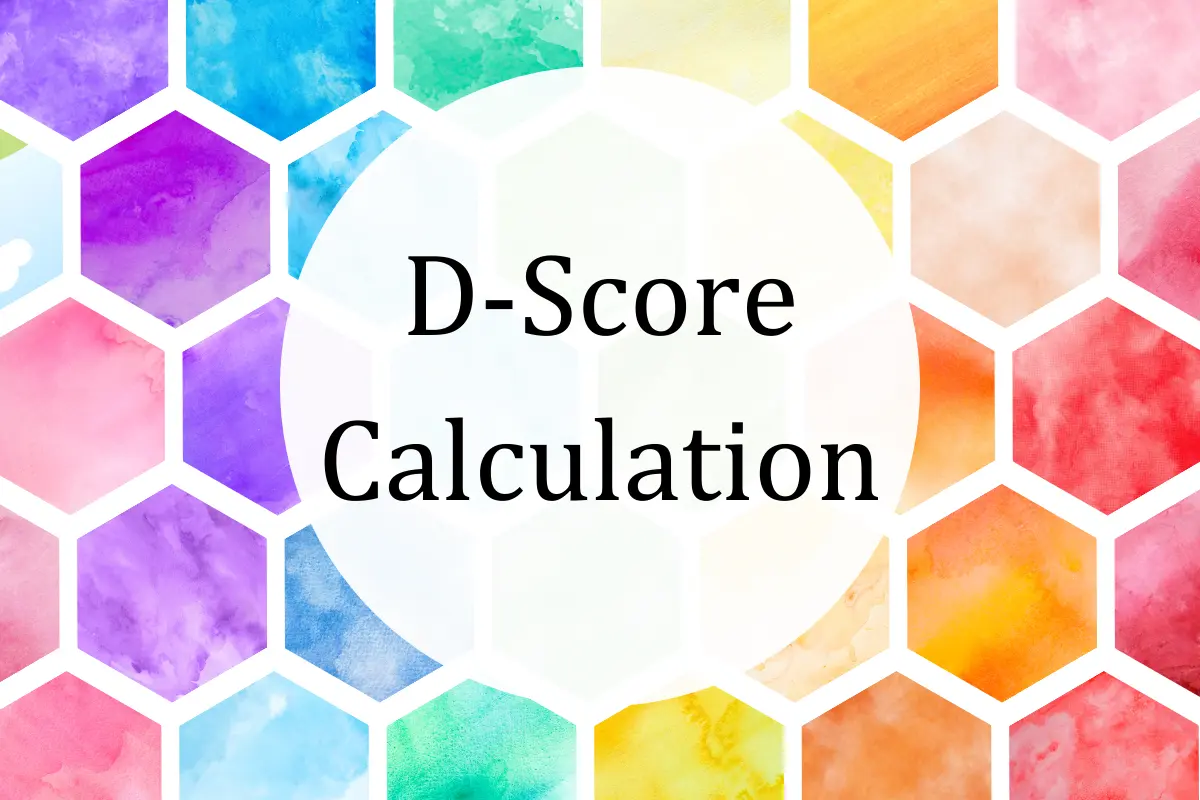In elite gymnastics, difficulty is assessed using the Difficulty Score (D-Score) under the FIG Code of Points. The D-score plays a crucial role in determining the total score of a gymnast’s performance.
Let’s explores how the D-score is calculated for both men’s and women’s gymnastics and highlights the key differences in their scoring systems.
The D-Score Components
The D-score in both men’s and women’s gymnastics is calculated based on three primary components:
- Highest-Valued Elements: The most difficult elements in the gymnast’s routine (Top 10 skills for men, Top 8 for women).
- Special Requirements: Mandatory skills that must be included in the routine for full difficulty credit.
- Connection Bonuses: Additional points awarded for successfully linking difficult skills.
Once the D-score is finalized, it is combined with the Execution Score (E-score), which starts at 10.0 and is reduced for technical and artistic errors. The final score is the sum of the D-score and the E-score.
1. Highest-Valued Elements
A gymnastics routine consists of many skills, but not all of them are included in the D-score calculation. Only the most difficult elements performed by the gymnast count toward the D-score.
| Gymnastics Discipline | Number of Skills Counted Toward the D-Score |
|---|---|
| Men’s Gymnastics (MAG) | 10 highest-difficulty elements |
| Women’s Gymnastics (WAG) | 8 highest-difficulty elements |
Letter-Based Difficulty Values
Each skill is assigned a letter rating (A to J), reflecting its complexity. Each letter corresponds to a specific point value, with higher letters signifying greater difficulty.
| Difficulty Rating | Men’s Gymnastics (MAG) Value | Women’s Gymnastics (WAG) Value |
|---|---|---|
| A | 0.1 | 0.1 |
| B | 0.2 | 0.2 |
| C | 0.3 | 0.3 |
| D | 0.4 | 0.4 |
| E | 0.5 | 0.5 |
| F | 0.6 | 0.6 |
| G | 0.7 | 0.7 |
| H | 0.8 | 0.8 |
| I | 0.9 | 0.9 |
| J | N/A | 1.0 |
What’s the Highest Difficulty Level in Gymnastics?
- The highest difficulty level in men’s gymnastics is I (0.9), while in women’s gymnastics, it is J (1.0).
Why the Difference?
Men’s routines allow more elements (10 vs. 8), so difficulty can accumulate via a greater number of high-value skills. This gives male gymnasts the opportunity to include a wider variety of challenging elements, spread across the apparatus.
In contrast, women’s routines consist of fewer elements, but they can feature skills rated J (1.0), allowing individual skills to reach the highest difficulty level. Women’s routines also tend to incorporate artistry and more complex dance elements, which add another layer of difficulty that is less prevalent in men’s routines.
2. Special Requirements
Beyond simply performing difficult elements, gymnasts must fulfill specific element group requirements to demonstrate well-rounded skill mastery. Meeting all these requirements adds points (typically up to 2.0) to the D-score. Missing any of these requirements results in a deduction, typically 0.5 per missing requirement from the final D-score.
Special Requirements in Men’s Artistic Gymnastics:
- Horizontal Bar: Specific grip types or swing elements.
- Rings: Strength holds and controlled body positions.
- Floor: Flight elements and jumps.
- Vault: A combination of approaches and dynamic vault skills.
Special Requirements in Women’s Artistic Gymnastics:
- Uneven Bars: Varied bar transitions, such as a mix of high-to-low and low-to-high bar movements.
- Balance Beam and Floor: Different types of leaps, acrobatic elements, and combinations of dance and acro skills.
- Vault: Varied vault families, with different approaches and landing techniques.
3. Connection Bonuses
Connection bonuses are extra difficulty points awarded for linking multiple high-value skills together in a routine. For instance:
- On the uneven bars, directly connecting two flight elements (like a release followed immediately by a catch) may yield a bonus of 0.1 or 0.2 points. The exact bonus depends on the difficulty ratings of the connected skills and whether both qualify as “flight” elements.
To earn the bonus, the transition between skills must be smooth, with no noticeable pause, hesitation, or break in rhythm. If a gymnast stumbles, hesitates, or makes a significant form error during the connection, the bonus may not be awarded.
This rule applies across all apparatuses: beam, bars, floor, and vault.
Men’s vs. Women’s Example Calculations
To better illustrate the calculation process, here are simplified examples for Men’s Gymnastics (MAG) and Women’s Gymnastics (WAG).
Men’s Gymnastics (MAG) – Example on High Bar
| Skill | Difficulty Rating (pts) |
|---|---|
| Endo with 360° turn to El-Grip | D (0.4) |
| Adler half turn | D (0.4) |
| Giant swing backward with hop 360° | C (0.3) |
| Tkatchev stretched | D (0.4) |
| Tkatchev with 180° turn | D (0.4) |
| Layout Jaeger with 360° turn | F (0.6) |
| Adler 360° turn to mixed grip | D (0.4) |
| Yamawaki | D (0.4) |
| Double twisting double layout dismount | E (0.5) |
| Total Skill Value | 4.1 |
- Special Requirements (grip variations, flight elements): +1.0
- Connection Bonuses (releases and transitions): +1.2
Final D-score = 6.3 points
Women’s Gymnastics (WAG) – Example on Floor
| Skill | Difficulty Rating (pts) |
|---|---|
| Biles II (Triple-Double Tucked) | J (1.0) |
| Moors (Double-Double Layout) | I (0.9) |
| Silivas (Double-Twisting Double Tuck) | H (0.8) |
| Dos Santos II (Arabian Double Layout) | G (0.7) |
| Triple Twist | F (0.6) |
| Double Arabian | E (0.5) |
| Leap Combination (2.5 turns) | C (0.3) |
| Double Pike | D (0.4) |
| Total Skill Value | 5.2 |
- Special Requirements (turns, leaps, acro variety): +1.0
- Connection Bonuses (dance + acro, back-to-back tumbling passes): +0.8
Final D-score = 7.0 points
Key D-Score Calculation Differences
In summary, the D-score is calculated differently for men’s and women’s gymnastics in the following ways:
| Factor | Men’s Gymnastics (MAG) | Women’s Gymnastics (WAG) |
|---|---|---|
| Skills Counted | 10 highest difficulty skills | 8 highest difficulty skills |
| Special Requirements | 5 per routine (-0.5 deduction per missing requirement) | 4 per routine (-0.5 deduction per missing requirement) |
| Connection Bonuses | More significant on High Bar, Parallel Bars, Floor | Essential for Beam, Bars, and Floor |
Bottom Line
While both men’s and women’s gymnastics use a D-score system based on skill difficulty, special requirements, and connection bonuses, the key differences lie in the number of skills counted and how high certain skills are valued.
- Men’s gymnastics: Allows more elements (10) and tops out at I (0.9) for the most difficult skills.
- Women’s gymnastics: Counts fewer elements (8), but can feature skills rated J (1.0). Women’s routines also rely more heavily on artistry and dance elements, which add complexity.
Both genders strive for a balance of high difficulty and flawless execution, but the specific route to achieving a high D-score varies between them.






